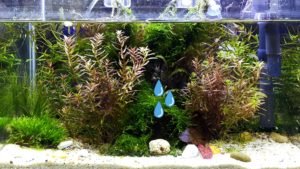Fish tank cleaning frequency is key to a healthy aquarium. Learn the ins and outs to keep your fish thriving and your tank looking great.
Do you ever wonder how often you should clean your fish tank to keep it pristine?
You’re not alone! This comprehensive guide will reveal the ideal fish tank cleaning frequency and share expert tips to help you maintain a healthy environment for your aquatic friends. So, let’s dive in!
Understanding Fish Tank Cleaning Frequency
Knowing how often to clean your fish tank is crucial for keeping your fish healthy. Several factors determine how often you should clean your fish tank, including the tank size, the number of fish, and the type of filtration system. Generally, you should perform a partial water change every 1-2 weeks and a full tank cleaning every 4-6 weeks. However, these intervals may vary depending on your tank’s specific needs.
The Importance of Regular Fish Tank Maintenance
Regular fish tank maintenance is crucial for several reasons:
- Water Quality: Over time, fish waste, uneaten food, and decaying plant matter can negatively impact the water quality, making it unhealthy for your fish. Regular cleaning helps maintain proper water parameters.
- Prevents Algae Growth: Algae can quickly grow in an unclean tank, causing an unsightly green film and reducing water quality. Routine cleaning helps prevent algae growth.
- Fish Health: Poor water quality can stress fish and make them more susceptible to disease. Regular cleaning ensures a healthy environment for your aquatic pets.
Fish Tank Cleaning Equipment and Products
You’ll need the right equipment and products to clean your fish tank effectively. Here are some essential items to consider:
- Fish Tank Cleaning Gloves: These gloves protect your hands from chemicals and bacteria while cleaning your tank. They also prevent the transfer of oils and contaminants from your skin to the tank.
- Siphon or Gravel Vacuum: A siphon or gravel vacuum helps remove debris and waste from the substrate while performing a water change.
- Algae Scraper or Pad: An algae scraper or pad removes algae from the tank’s glass surfaces.
- Fish Net: A fish net is handy for removing debris and catching fish if you need to transfer them during cleaning.
- Water Conditioner: A water conditioner is essential when adding new water to your tank, as it neutralizes chlorine and other harmful chemicals.
- Fish Tank Cleaning Liquid: These cleaning solutions are designed specifically for fish tanks and help remove grime and buildup without harming your fish.
- Fish Tank Cleaning Products: Various products, such as filter cleaning brushes and glass cleaners, are available to make the cleaning process more manageable.
Fish Tank Cleaner Chloroquine
Chloroquine is sometimes used in fish tanks to treat certain diseases, such as Cryptocaryon irritants (marine ich) and freshwater ich. Following the manufacturer’s instructions and consulting with a veterinarian or fish expert before using chloroquine in your fish tank is crucial. Chloroquine is not a regular cleaning product and should only be used when necessary.
Achieving Fish Tank Clarity
A crystal-clear fish tank is visually appealing and indicates a healthy environment. To achieve fish tank clarity, consider the following tips:
- Regular Water Changes: Partial water changes every 1-2 weeks help maintain water quality and clarity.
- Proper Filtration: Ensure you have the right filter for your tank size and clean it regularly.
- Use a Clarifier: Water clarifiers help remove fine particles suspended in the water, making it appear more precise.
- Maintain a Balanced Aquarium (Continued): Overstocking your tank or overfeeding your fish can lead to poor water quality and reduced clarity. Please keep the correct number of fish for your tank size and feed them appropriately.
- Use Live Plants: Live plants can help improve water quality by absorbing excess nutrients, contributing to water clarity.
Fish Tank Cleaning Tips
To make your fish tank cleaning routine more efficient, consider these expert tips:
- Plan Ahead: Schedule your cleaning tasks to ensure you have enough time to complete them correctly. That will also help you avoid rushing through the process and potentially causing harm to your fish.
- Remove Fish: If you’re performing a deep clean, consider temporarily relocating your fish to a separate container filled with tank water. That will minimize stress on the fish and make cleaning the tank easier.
- Test Water Quality: Regularly test your tank water for ammonia, nitrite, nitrate, pH, and other parameters to ensure optimal conditions for your fish.
- Clean Filters: Make sure to clean your filters as needed. A clogged filter can reduce its efficiency, leading to poor water quality.
- Scrub Decorations: Algae and debris can accumulate on tank decorations. Regularly scrub them to maintain their appearance and prevent buildup.
Creating a Fish Tank Cleaning Routine
Developing a regular cleaning routine will make maintaining your fish tank more accessible and more efficient. Here’s a suggested schedule to follow:
- Daily: Check the water temperature, observe your fish for signs of illness, and remove any uneaten food or debris.
- Weekly: Perform a partial water change (20-30% of the tank’s volume), clean the glass surfaces, and check the water parameters.
- Monthly: Inspect and clean the filter, scrub tank decorations, and vacuum the substrate.
- Every 4-6 weeks: Perform a thorough tank cleaning, which may include temporarily removing the fish, cleaning the substrate, and scrubbing all surfaces.
Common Fish Tank Cleaning Mistakes to Avoid
To ensure the health and safety of your fish, avoid these common fish tank cleaning mistakes:
- Using Household Cleaners: Household cleaning products can contain harmful chemicals that are toxic to fish. Always use products designed specifically for fish tanks.
- Overcleaning: While keeping your fish tank clean is essential, overcleaning can disrupt the tank’s balance and stress your fish. Stick to the recommended cleaning schedule and avoid going overboard.
- Neglecting Water Changes: Regular water changes are crucial for maintaining water quality. Skipping water changes can lead to poor water conditions and sick fish.
- Not Rinsing Equipment: Be sure to rinse all equipment, such as siphons, nets, and scrubbers, before and after use to prevent the transfer of contaminants.
The Role of Live Plants in Your Fish Tank
Live plants can play an essential role in maintaining the health and cleanliness of your fish tank. They absorb excess nutrients, such as ammonia and nitrites, helping to maintain water quality. Additionally, live plants provide shelter and hiding spots for fish, reducing stress and contributing to a more stable environment. When choosing live plants, research their specific needs and compatibility with your fish species to ensure a thriving tank.
Proper Fish Feeding Practices
Overfeeding is one of the leading causes of poor water quality in fish tanks. Uneaten food and fish waste can accumulate, increasing ammonia and nitrite levels. To avoid overfeeding, provide only the amount of food your fish can consume within a few minutes, and remove any uneaten food after feeding. Also, consider feeding your fish a varied diet to ensure they receive all the nutrients for good health.
Establishing a Healthy Bacterial Balance
Beneficial bacteria are vital in breaking down harmful substances in your fish tank. These bacteria convert ammonia to nitrite and nitrite to nitrate, which is less dangerous and can be removed through water changes or absorbed by live plants. To promote the growth of beneficial bacteria, provide adequate filtration, and avoid overcleaning your tank. You can also use bacterial supplements to kick-start the cycling process or replenish beneficial bacteria after cleaning.
Monitoring Water Parameters
Regularly testing the water parameters in your fish tank can help you identify any imbalances or issues before they become critical. Invest in a quality aquarium test kit to measure ammonia, nitrite, nitrate, pH, and water hardness. By keeping these parameters within acceptable ranges, you can maintain a stable and healthy environment for your fish.
Conclusion
Establishing an appropriate fish tank cleaning frequency is crucial for maintaining a healthy environment for your fish. Considering factors such as tank size, fish species, and filtration system, you can create a tailored cleaning schedule that meets your needs. With proper care and attention, you can enjoy a beautiful and thriving fish tank that you and your fish will love.

Decoding the Fish Tank Losing Water but No Leak Puzzle
Find out the unexpected causes of fish tank losing water but no leak and gain valuable knowledge on how to address this perplexing problem. Have you ever noticed your fish tank losing water but can’t find a leak? If so, you’re not alone. Many fish tank owners have encountered this puzzling issue, which can be

Essential Fish Tank Tips for a Happy, Healthy Aquarium
Are you looking for the best fish tank tips to ensure a thriving environment for your aquatic pets? You’ve come to the right place! This comprehensive guide covers everything from fish tank maintenance to creating the perfect setting for your fish. So let’s dive right in and discover how to make your fish tank the

Mickey Mouse Platy: Vibrant and Fascinating Aquarium Pets
Are you considering adding a colorful and fascinating fish to your aquarium? Look no further than the Mickey Mouse platy! These charming little fish are known for their unique markings and friendly nature, making them perfect for beginners and experienced aquarists. In this guide, we’ll delve into everything you need to know about Mickey Mouse

